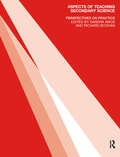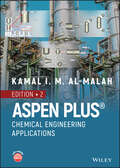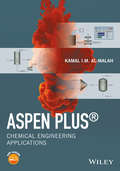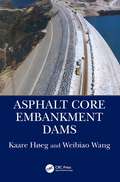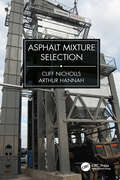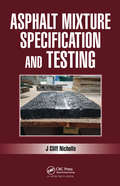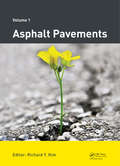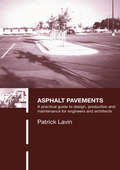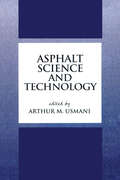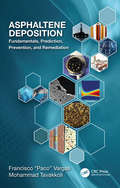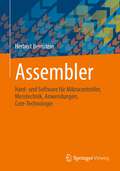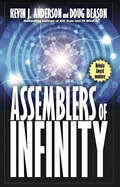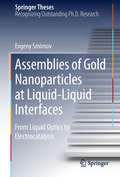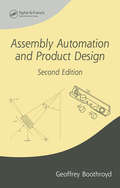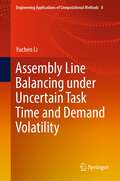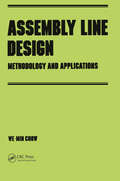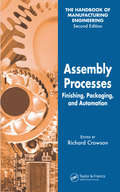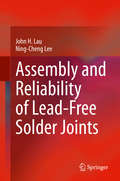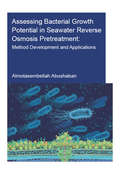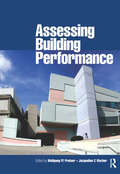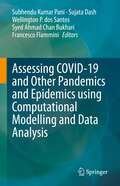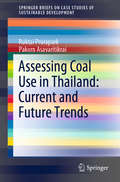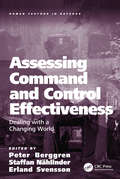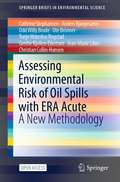- Table View
- List View
Aspects of Teaching Secondary Science: Perspectives on Practice
by Sandra Amos Richard BoohanThis book's structure reflects the different dimensions to learning science. The first section focuses on the importance of talk in the science classroom, while the second explores the key role of practical work. The third section is concerned with the creative, theoretical aspect of science. Section four follows this by considering the communication of ideas and how pupils learn to participate in the discourse of the scientific community. Section five emphasizes the place of science in the broader context, considering its moral and ethical dimensions and its place in a cultural context. Finally, section six explores the complexity of the task faced by science teachers, highlighting the knowledge and skills science teachers must acquire in order to create an environment in which students are motivated to learn science.
Aspen Plus: Chemical Engineering Applications
by Kamal I. Al-MalahASPEN PLUS® Comprehensive resource covering Aspen Plus V12.1 and demonstrating how to implement the program in versatile chemical process industries Aspen Plus®: Chemical Engineering Applications facilitates the process of learning and later mastering Aspen Plus®, the market-leading chemical process modeling software, with step-by-step examples and succinct explanations. The text enables readers to identify solutions to various process engineering problems via screenshots of the Aspen Plus® platforms in parallel with the related text. To aid in information retention, the text includes end-of-chapter problems and term project problems, online exam and quiz problems for instructors that are parametrized (i.e., adjustable) so that each student will have a standalone version, and extra online material for students, such as Aspen Plus®-related files, that are used in the working tutorials throughout the entire textbook. The second edition of Aspen Plus®: Chemical Engineering Applications includes information on: Various new features that were embedded into Aspen Plus V12.1 and existing features which have been modified Aspen Custom Modeler (ACM), covering basic features to show how to merge customized models into Aspen Plus simulator New updates to process dynamics and control and process economic analysis since the first edition was published Vital areas of interest in relation to the software, such as polymerization, drug solubility, solids handling, safety measures, and energy saving For chemical engineering students and industry professionals, the second edition of Aspen Plus®: Chemical Engineering Applications is a key resource for understanding Aspen Plus and the new features that were added in version 12.1 of the software. Many supplementary learning resources help aid the reader with information retention.
Aspen Plus: Chemical Engineering Applications
by Kamal I.M. Al-MalahFacilitates the process of learning and later mastering Aspen Plus® with step by step examples and succinct explanations Step-by-step textbook for identifying solutions to various process engineering problems via screenshots of the Aspen Plus® platforms in parallel with the related text Includes end-of-chapter problems and term project problems Includes online exam and quiz problems for instructors that are parametrized (i.e., adjustable) so that each student will have a standalone version Includes extra online material for students such as Aspen Plus®-related files that are used in the working tutorials throughout the entire textbook
Asphalt Core Embankment Dams
by Kaare Høeg Weibiao WangDams are built for several purposes, e.g., water supply, irrigation, hydropower production, or flood control. The main categories are concrete dams and embankment dams, but inside each of these two main general categories, there are several different types. Asphalt Core Embankment Dams focusses on the design and construction of these types of dams. Asphalt core embankment dams are gaining in popularity, as their recorded field performance is excellent, they are economically very competitive, and the construction period may be shortened compared to other types of embankment dams. This book presents several case studies of dams that have been successfully built and been in service for many years, and: introduces the concept of using asphalt concrete core rather than earth core or upstream facing; points out there is no concern about internal erosion when using hydraulic asphalt concrete in the core; discusses material selection and mix design for hydraulic asphalt concrete to achieve flexibility and ductility; discusses suitability testing and asphalt concrete mix improvements and optimization by using additives; presents the use of triaxial tests, tension tests, and bending tests to study cracking resistance and potential self-healing; discusses the use of modern construction equipment and field quality control; shows that asphalt core dams may reduce the construction period compared to other options; and treats earthquake resistance of this type of dams. The authors have built on decades of experience with the design and construction, construction control, and research and development for asphalt core embankment dams. Asphalt Core Embankment Dams is aimed at engineering students, practising engineers, civil engineering contractors, equipment suppliers, and asphalt producers.
Asphalt Mixture Selection
by Cliff Nicholls Arthur HannahThis practical guide starts with a survey of the types of site and the asphalt properties which are required. Various external influences which may affect the relative importance of some properties are addressed, and the interplay of sites and external is considered. Asphalt mixture types and their properties are reviewed, largely as defined in the EN 13108 series but subdivided into further categories, and into maximum nominal coarse aggregate sizes using EN 13043 basic set plus set 2 sizes. Guidance is given, including using flowcharts, of the different mixtures that are suitable for each situation. In some cases a range of choices or mixtures with different degrees of suitability is offered. The guidance covers surface course, binder course and base, but with more focus on the surface course where the external influence is most significant. The site and external influence combinations on which a mixture can be used successfully are also given. The book is primarily intended for those who select asphalt on an occasional basis, such as architects or housing developers, but could be of use to other engineers with limited experience. It is also useful as an educational textbook for those studying asphalt technology.
Asphalt Mixture Specification and Testing
by Cliff NichollsThis guide reviews the way asphalt mixture can be specified, with particular emphasis on the test methods used to measure performance. The advantages and limitations of the tests are described for measuring the desired property, and engineers can specify a test according to the material’s use. The book starts with a resume of specifications and their relative advantages and disadvantages for different situations. Then different properties are discussed in terms of: their specification; the test methods that can be used (primarily the EN 12697 suite of European methods, of which the author has been responsible for drafting); the extent to which the results predict performance; the levels that can be achieved with different asphalt mixes and types; what levels, if any, should be specified in various situations and pavement layers; and which other properties are adversely affected by enhanced performance. The final section covers various aspects of sustainability, with a strong emphasis on durability. Better understanding should enable clients and consultants who specify pavements to produce durable asphalt pavements more economically, and also help asphalt producers and students trying to understand the black art of asphalt.
Asphalt Pavements
by Y. Richard KimAsphalt Pavements contains the proceedings of the International Conference on Asphalt Pavements (Raleigh, North Carolina, USA, 1-5 June 2014), and discusses recent advances in theory and practice in asphalt materials and pavements. The contributions cover a wide range of topics:- Environmental protection and socio-economic impacts- Additives and mo
Asphalt Pavements: A Practical Guide to Design, Production and Maintenance for Engineers and Architects
by Patrick LavinAsphalt Pavements provides the know-how behind the design, production and maintenance of asphalt pavements and parking lots. Incorporating the latest technology, this book is the first to focus primarily on the design, production and maintenance of low-volume roads and parking areas.Special attention is given to determining the traffic capacity, re
Asphalt Science and Technology
by Arthur Usmani"Offers comprehensive, authoritative coverage of the chemistry, technology, and engineering of asphaltic products for paving, road construction, roofing, coatings, adhesives, and batteries. Analyzes microcracking and elucidates the mechanisms of degradation to aid the development of hot melt asphalt and increase longevity."
Asphaltene Deposition: Fundamentals, Prediction, Prevention, and Remediation
by Francisco M. Vargas and Mohammad TavakkoliAs global consumption of fossil fuels such as oil increases, previously abundant sources have become depleted or plagued with obstructions. Asphaltene deposition is one of such obstructions which can significantly decrease the rate of oil production. This book offers concise yet thorough coverage of the complex problem of asphaltene precipitation and deposition in oil production. It covers fundamentals of chemistry, stabilization theories and mechanistic approaches of asphaltene behavior at high temperature and pressure. Asphaltene Deposition: Fundamentals, Prediction, Prevention, and Remediation explains techniques for experimental determination of asphaltene precipitation and deposition and different modeling tools available to forecast the occurrence and magnitude of asphaltene deposition in a given oil field. It discusses strategies for mitigation of asphaltene deposition using chemical inhibition and corresponding challenges, best practices for asphaltene remediation, current research, and case studies.
Assembler: Hard- und Software für Mikrocontroller, Messtechnik, Anwendungen, Core-Technologie
by Herbert BernsteinIn diesem Fachbuch für Assemblerprogrammierung werden die erforderlichen Kenntnisse auf dem Gebiet der Hardware und Software in einander greifend erklärt. Es wird in zahlreichen Applikationen das Zusammenspiel der einzelnen Steuerbits und -worte anhand praktischer Anwendungen dargestellt.
Assemblers of Infinity
by Kevin J. Anderson Doug BeasonEarth&’s thriving lunar colony faces a mysterious, growing threat on the far side of the Moon . . . an alien invasion or nanotechnology run amuck. The crew of Moonbase Columbus makes an amazing discovery on the far side of the Moon—a massive alien structure is erecting itself, built up atom by atom by living machines, microscopically small, intelligent, and unstoppable, consuming everything they touch. The mysterious structure begins to expand and take shape, and its creators begin to multiply. Is this the first strike in an alien invasion from the stars? Is it an attempt at first contact? Or has human nanotechnology experimentation gone awry, triggering an unexpected infestation? As riots rage across a panicked Earth, scientists scramble to learn the truth before humanity&’s home is engulfed by the voracious machines. Praise for Assemblers of Infinity Nebula Award Nominee &“The authors have a fine grasp of character and a slick writing style.&” —Science Fiction Review&“Anderson and Beason are the heavyweight tag-team of hard science fiction!&” —Allen Steele, author of Labyrinth of Night&“Wonderfully vivid, Terrifying, and worse yet . . . realistic!&” —David Brin, author of Startide Rising
Assemblies of Gold Nanoparticles at Liquid-Liquid Interfaces: From Liquid Optics to Electrocatalysis (Springer Theses)
by Evgeny SmirnovNominated as an outstanding Ph.D. thesis by the École Polytechnique Fédérale de Lausanne, Switzerland.<P><P> Shows the self-assembly of gold nanoparticles into nanoparticles films Investigates the optical, mechanical and electrochemical properties of metal liquid-like droplets.<P> Explores the elctrocatalytic capability of nanoparticles placed at the interface.<P> This book is devoted to various aspects of self-assembly of gold nanoparticles at liquid-liquid interfaces and investigation of their properties. It covers primarily two large fields: (i) self-assembly of nanoparticles and optical properties of these assemblies; and (ii) the role of nanoparticles in redox electrocatalysis at liquid-liquid interfaces. The first part aroused from a long-lasting idea to manipulate adsorption of nanoparticles at liquid-liquid with an external electric field to form 'smart' mirrors and/or filters. Therefore, Chapters 3 to 5 are dedicated to explore fundamental aspects of charged nanoparticles self-assembly and to investigate optical properties (extinction and reflectance) in a through manner. Novel tetrathiafulvalene (TTF)-assisted method leads to self-assembly of nanoparticles into cm-scale nanofilms or, so-called, metal liquid-like droplets (MeLLDs) with remarkable optical properties. The second part (Chapters 6 to 8) clarifies the role of nanoparticles in interfacial electron transfer reactions. They demonstrate how nanoparticles are charged and discharged upon equilibration of Fermi levels with redox couples in solution and how it can be used to perform HER and ORR. Finally, Chapter 9 gives a perspective outlook, including applications of suggested methods in fast, one-step preparation of colloidosomes, SERS substrates as well as pioneer studies on so-called Marangony-type shutters drive by the electric field.
Assembly Automation and Product Design (ISSN)
by Geoffrey BoothroydThe design for assembly (DFA) method has become a widely used way for companies to introduce competitive designs at reduced costs. This text places the consideration and application of automatic assembly in the context of DFA, addressing product design for both automated and manual assembly processes. The author enumerates the components, processes, performance, and comparative economics of several types of automatic assembly systems. To this end, the book includes specific information on equipment such as transfer devices, parts feeders, feed tracks, placing mechanisms, and robots. This is an ideal reference and guide for manufacturing, product design, mechanical, and industrial engineers.
Assembly Line Balancing under Uncertain Task Time and Demand Volatility (Engineering Applications of Computational Methods #8)
by Yuchen LiThis book introduces several mathematical models in assembly line balancing based on stochastic programming and develops exact and heuristic methods to solve them. An assembly line system is a manufacturing process in which parts are added in sequence from workstation to workstation until the final assembly is produced. In an assembly line balancing problem, tasks belonging to different product models are allocated to workstations according to their processing times and precedence relationships among tasks. It incorporates two features, uncertain task times, and demand volatility, separately and simultaneously, into the conventional assembly line balancing model. A real-life case study related to the mask production during the COVID-19 pandemic is presented to illustrate the application of the proposed framework and methodology. The book is intended for graduate students who are interested in combinatorial optimizations in manufacturing with uncertain input.
Assembly Line Design: Methodology and Applications
by We-Min ChowThis book attempts to treat line design and its related subjects in a cohesive manner, with an emphasis on design applications. It discusses general guidelines for setting up assumptions and determining line performance parameters, based on empirical data from literature reports.
Assembly Processes: Finishing, Packaging, and Automation (Handbook of Manufacturing Engineering, Second Edition)
by Richard CrowsonToday's fast-paced manufacturing culture demands a handbook that provides how-to, no-holds-barred, no-frills information. Completely revised and updated, the Handbook of Manufacturing Engineering is now presented in four volumes. Keeping the same general format as the first edition, this second edition not only provides more information but makes i
Assembly and Reliability of Lead-Free Solder Joints
by John H. Lau Ning-Cheng LeeThis book focuses on the assembly and reliability of lead-free solder joints. Both the principles and engineering practice are addressed, with more weight placed on the latter. This is achieved by providing in-depth studies on a number of major topics such as solder joints in conventional and advanced packaging components, commonly used lead-free materials, soldering processes, advanced specialty flux designs, characterization of lead-free solder joints, reliability testing and data analyses, design for reliability, and failure analyses for lead-free solder joints. Uniquely, the content not only addresses electronic manufacturing services (EMS) on the second-level interconnects, but also packaging assembly on the first-level interconnects and the semiconductor back-end on the 3D IC integration interconnects. Thus, the book offers an indispensable resource for the complete food chain of electronics products.
Assessing Accomplished Teaching: Advanced-Level Certification Programs
by National Research Council of the National AcademiesThe mission of the National Board for Professional Teaching Standards (NBPTS) is to establish “high and rigorous standards for what teachers should know and be able to do, to certify teachers who meet those standards, and to advance other education reforms for the purpose of improving student learning in American schools.” In response to a request from the U.S. Congress, the National Research Council developed a framework for evaluating programs that award advanced-level teacher certification and applied that framework in an evaluation of the impacts of the NBPTS. Specifically, this book addresses the impacts on students, teachers, and the educational system in this country. Assessing Accomplished Teaching finds that teachers who earn board certification are more effective at improving their students’ achievement than other teachers, but school systems vary greatly in the extent to which they recognize and make use of board-certified teachers. Many of the questions on the evaluation framework could not be answered because the data have not been collected, and the report makes recommendations for the kinds of research that are needed to fully evaluate the impacts of board certification by the NBPTS.
Assessing Bacterial Growth Potential in Seawater Reverse Osmosis Pretreatment: Method Development and Applications (IHE Delft PhD Thesis Series)
by Almotasembellah AbushabanSeawater desalination is increasingly being used as a means to augment freshwater supplies in regions with high water stress, and reverse osmosis is increasingly the technology of choice because of the low energy consumption. However, seawater reverse osmosis (SWRO) systems suffer from various types of fouling, which can increase energy consumption and the use of chemicals during SWRO operation. In practice, pre-treatment systems are put in place to reduce the particulate and biological fouling potential of SWRO feed water. However, simple, reliable and accurate methods to assess the extent to which biological fouling potential is reduced during pre-treatment are not available for seawater. This research developed a new method to measure bacterial growth potential (BGP) using the native bacterial consortium in seawater. New reagents to extract and detect ATP in microbial cells were specifically developed for seawater. The new lysis and detection reagents overcame the salt interference in seawater and allow low detection of total ATP, free ATP and microbial ATP in seawater. Incorporating a filtration step further increased the sensitivity of the method six fold, enabling ATP detection of ultra-low levels of microbial ATP in seawater. The newly developed ATP-based BGP method was applied to monitor and assess the pre-treatment of five full-scale seawater desalination plants around the world. A good correlation was observed between BGP measured in SWRO feed water and the pressure drop increase in the SWRO systems, suggesting the applicability of using the ATP-based BGP method as a biofouling indicator in SWRO. Furthermore, a safe level of BGP ( In the future, on-line monitoring of BGP in SWRO feed water may further reduce the consumption of chemicals and energy and improve the overall sustainability of seawater desalination by reverse osmosis.
Assessing Building Performance
by Wolfgang F.E. Preiser Jacqueline C. VischerThe building performance evaluation (BPE) framework emphasizes an evaluative stance throughout the six phases of the building delivery and life cycle: (1) strategic planning/needs analysis; (2) program review; (3) design review; (4) post-construction evaluation/review; (5) post-occupancy evaluation; and, (6) facilities management review/adaptive reuse.The lessons learned from positive and negative building performance are fed into future building delivery cycles. The case studies illustrate how this basic methodology has been adapted to a range of cultural contexts, and indicates the positive results of building performance assessment in a wide range of situations.
Assessing COVID-19 and Other Pandemics and Epidemics using Computational Modelling and Data Analysis
by Francesco Flammini Sujata Dash Subhendu Kumar Pani Wellington P. dos Santos Syed Ahmad Chan BukhariThis book comprehensively covers the topic of COVID-19 and other pandemics and epidemics data analytics using computational modelling. Biomedical and Health Informatics is an emerging field of research at the intersection of information science, computer science, and health care. The new era of pandemics and epidemics bring tremendous opportunities and challenges due to the plentiful and easily available medical data allowing for further analysis. The aim of pandemics and epidemics research is to ensure high-quality, efficient healthcare, better treatment and quality of life by efficiently analyzing the abundant medical, and healthcare data including patient’s data, electronic health records (EHRs) and lifestyle. In the past, it was a common requirement to have domain experts for developing models for biomedical or healthcare. However, recent advances in representation learning algorithms allow us to automatically learn the pattern and representation of the given data for the development of such models. Medical Image Mining, a novel research area (due to its large amount of medical images) are increasingly generated and stored digitally. These images are mainly in the form of: computed tomography (CT), X-ray, nuclear medicine imaging (PET, SPECT), magnetic resonance imaging (MRI) and ultrasound. Patients’ biomedical images can be digitized using data mining techniques and may help in answering several important and critical questions related to health care. Image mining in medicine can help to uncover new relationships between data and reveal new and useful information that can be helpful for scientists and biomedical practitioners. Assessing COVID-19 and Other Pandemics and Epidemics using Computational Modelling and Data Analysis will play a vital role in improving human life in response to pandemics and epidemics. The state-of-the-art approaches for data mining-based medical and health related applications will be of great value to researchers and practitioners working in biomedical, health informatics, and artificial intelligence..
Assessing Coal Use in Thailand: Current and Future Trends (SpringerBriefs on Case Studies of Sustainable Development)
by Ruktai Prurapark Pakorn AsavaritikraiThis book highlights Thailand’s growing demand for clean energy from coal. The main source of energy for electricity production in Thailand (70%) is currently natural gas. However, natural gas extraction remains limited, resulting in an increasing need to import natural gas from other countries, which in turn leads to rising prices and unstable supplies. As such, coal energy is essential for industrial use and electricity production in Thailand. The book discusses the importance of developing and implementing clean technologies for coal. It also argues that collaborations between the government, private sector and the public are vital to achieving a mutual understanding and acceptance of coal energy and clean technologies, as well as a reduction in harmful emissions.
Assessing Command and Control Effectiveness: Dealing with a Changing World (Human Factors in Defence)
by Peter Berggren Staffan Nählinder Erland SvenssonAssessing Command and Control Effectiveness: Dealing with a Changing World offers a description of the current state of Command and Control (C2) research in imperfect settings, showing how a research process should assess, analyse and communicate results to the development cycle of methods, work, manning and C2-technology. Special attention is given to the development of C2 research methods to meet the current and coming needs. The authors also look forward towards a future where effective assessment of C2 abilities are even more crucial, for instance in agile organisations. The purpose of the C2 research is to improve the process and make it more effective while still saving time and money. Research methods have to be chosen carefully to be effective and simple, yet provide results of high quality. The methodological concerns are a major consideration when working under such circumstances. Furthermore, there is often a need for a swift iterative development cycle, and thus a demand to quickly deliver results from the research process. This book explains how field research experimentation can be quick, simple and effective, being able to draw valid conclusions even when sample sizes are small and resources are limited, collecting empirical data using measures and procedures that are minimally intrusive.
Assessing Environmental Risk of Oil Spills with ERA Acute: A New Methodology (SpringerBriefs in Environmental Science)
by Cathrine Stephansen Anders Bjørgesæter Odd Willy Brude Ute Brönner Tonje Waterloo Rogstad Grethe Kjeilen-Eilertsen Jean-Marie Libre Christian Collin-HansenThis open access book introduces readers to a new methodology for assessing the risks to the marine environment following accidental oil spills. The methodology will soon be implemented on the Norwegian Continental Shelf and will be complemented by guidelines for its use in a regulatory framework. The brief book is intended to provide international readers with a basic grasp of what the ERA Acute methodology consists of, what its applications are, and the underlying impact and restoration models used in its development. The content is divided into three main parts: an introduction and overview of risk management applications for generalists at the management level, a model overview for generalist scientists, and a more detailed final section for risk assessment professionals, which presents the results of the validation and sensitivity testing.
